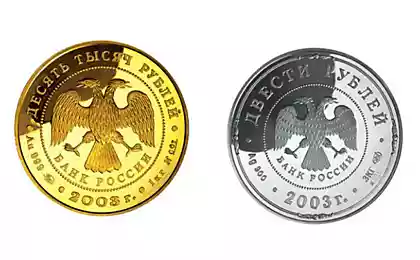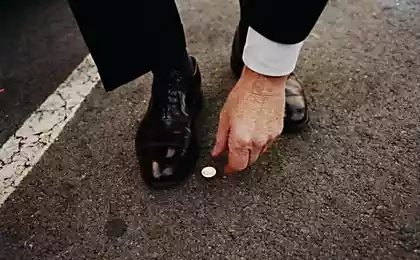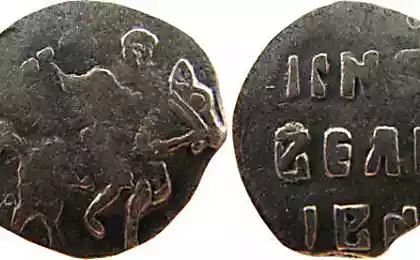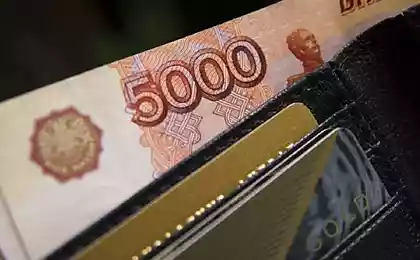1064
Financial disaster
Money - not a reliable thing, none of us can not control them, they can suddenly appear, as well as disappear.
You work three jobs, postpone these unfortunate pieces of paper, and they are just worthless.
1. In Argentina, disappeared detail - nobody knows why

Imagine you came to the supermarket, and there in front of you apologize and say that now can not sell anything. Then you decide to drop into a small shop to buy at least a bottle of milk. Served cashier bill and it stretches you, instead of putting a box of chocolates. And you're on a diet. You sit down on a bus, but you do not have stuff to buy a ticket. The driver understands what your problem is and offers to exchange your large bills on a trifle, but ... 60 times cheaper than face value.

This mysterious shortage of trivia arose several years ago in Argentina. Nobody really knows where in the third largest economy in Latin America suddenly are all the coins. Argentina's government has accused the ordinary citizens that they allegedly hoarding or melted coins because of the relatively high cost of the metal. People blamed the government for the fact that it is not a sufficient number of coins minted, although in 2008 it was produced 500 million small coins. Whatever it was, but the situation was exacerbated by a trifle every day.
Trade has become a nightmare. Surrender was absolutely nothing to give. Large shops simply closed, and fine imposed instead of putting buyers and chocolate chips. Even banks - the places where they live money, set a limit on the issuance of coins in one hand, despite the threats of the government, that such restrictions would be punished by heavy fines.
Most fortunate bus drivers in Buenos Aires, where the board accepts only coins of a certain value. During this period, they have risen strongly, selling a coin many times more expensive than face value.
2. Entrepreneurs are printing their own money

In 1862, when America went for the second year of the civil war, the government minted coins disappeared from circulation. To conduct any business would become almost impossible, because the government was divided into two parts, and each began to print their own paper money.
In the end, different businesses have started to mint their own banknotes, known today as the Civil War tokens. These tokens and walked among the shopkeepers, and the military, they were used by ordinary citizens. Usually token indicated or the name and location minted its business or any patriotic slogan (or more), such as "If you see that someone is trying to break the American flag - shoot him on the spot».
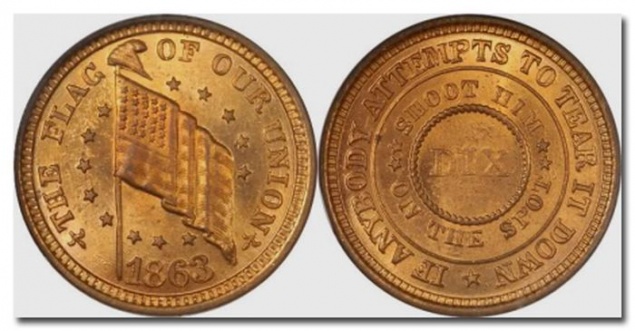
The problem was that, because at that time the US economy was still tied to the gold standard, then for each printed or minted form of existence of the currency stood a certain amount of gold stored in the vaults of the government.
This means that all that went up in a huge number of "private" money, in fact, completely worthless.

Over the fact that in 1864 the federal government intervened, strictly prohibiting the circulation of various kinds of tokens, tickets and coupons. For violators of the penal system was installed - by a fine of two thousand dollars up to five years in prison.
3. British ship to print money

Imagine: you look in your mailbox and find a hefty wad of cash.
You are in a hurry to share the unexpected joy with friends, but it turns out that each of them received exactly the same parcel. The next day you find in your mailbox more money. It takes quite a bit of time and money has nowhere to go. The wind carries them on the road as the fallen leaves of autumn. The papers appear ad offering money for the price of paper on which they are printed ...
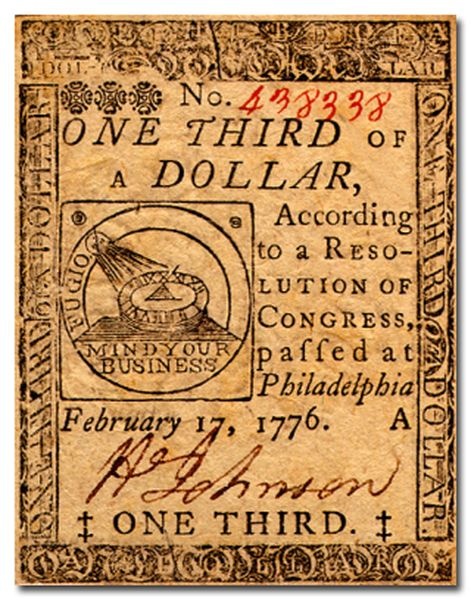
The first attempt of Americans to print paper money was made in 1775, at the beginning of the War of Independence. Continental Congress (the legislative body of the future United States; approx. Mixstuff.ru) issued notes, known as "continental dollars" which are supposed to cover military spending. The economy at that time was not yet tied to the gold standard, so that physically continental dollar was no Navy obespechen.Britansky to thwart the enemy, he built a similar printing press on board a warship Phoenix, standing in New York Harbor, and began print false "Continental". It was the first war in the history of financial diversiya.Plan lay in the fact that the credibility of the new currency, to bring down the US economy and lead Britain to victory. The quality of the fakes was pretty decent, and soon they are really flooded the market. American settlers, in full accordance with the concept of the British, began to treat the continental dollar suspicious and refused to deal with him. They have ceased to pay and accept as platy.Britantsy were so confident in the success of their enterprise, even and not particularly hide what they were doing. In 1777 they were literally placed in the New York newspapers ads offering to sell counterfeit money at the price bumagi.K 1781 counterfeit banknotes completely destroyed the value of the Continental dollar, and Congress decided to withdraw them from circulation.
4. The Hungarian inflation at 13 600 000 000 000 000 percent

Imagine - you go to the bakery and going to the box office, discover that you forgot wallet at home. You sigh, you put a loaf on the shelf and weaves home for the money. And having returned less than an hour, you can see on the price tag twice the figure. The next day, the price of a loaf of flies five times more. And by the end of the month it is necessary to lay out as much as you used to be given for a slightly used car ...
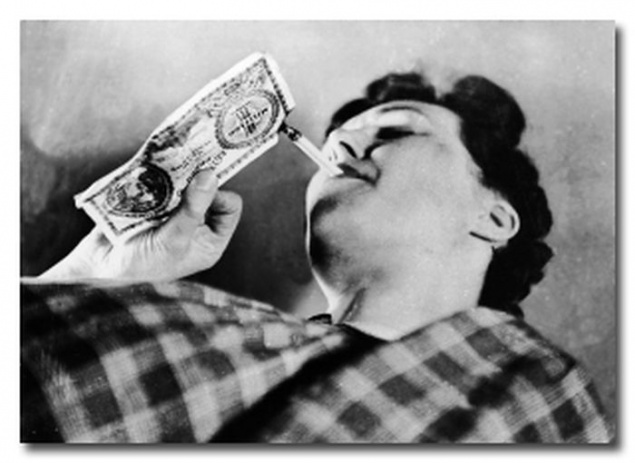
In 1945-46 Hungary was going through perhaps the most rapid hyperinflation in world history. At the peak it reached 200 percent on the day, prices doubled every 15 chasov.V early twenties Hungary, like other countries affected by World War I, was gripped by inflation, the result of which was the currency reform in 1925. In place of the Hungarian crown came pengos secured gold, which for some time has become the most stable currency in the region. And after World War II Hungary lost more than 40 percent of its capital. In addition, she had to pay huge compensation to the Soviet Union, which amounts to about 25-50 percent of the budget Vengrii.Vengerskoe government found nothing better than to run the printing press at full capacity. Pengos depreciated more and more. In the end, it was necessary to issue denominations of 100 million and 1 billion pengё.I only after introduced a completely new backed by gold and foreign currency securities - "forint", managed to stop the free fall. And with the mountains of discarded pengos had to do only one thing:
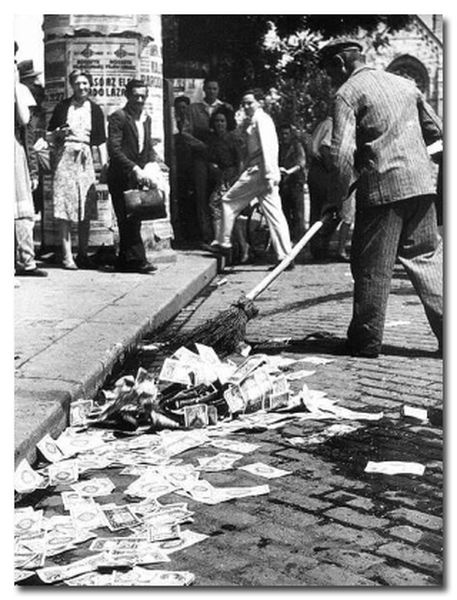
Source: mixstuff.ru
You work three jobs, postpone these unfortunate pieces of paper, and they are just worthless.
1. In Argentina, disappeared detail - nobody knows why

Imagine you came to the supermarket, and there in front of you apologize and say that now can not sell anything. Then you decide to drop into a small shop to buy at least a bottle of milk. Served cashier bill and it stretches you, instead of putting a box of chocolates. And you're on a diet. You sit down on a bus, but you do not have stuff to buy a ticket. The driver understands what your problem is and offers to exchange your large bills on a trifle, but ... 60 times cheaper than face value.

This mysterious shortage of trivia arose several years ago in Argentina. Nobody really knows where in the third largest economy in Latin America suddenly are all the coins. Argentina's government has accused the ordinary citizens that they allegedly hoarding or melted coins because of the relatively high cost of the metal. People blamed the government for the fact that it is not a sufficient number of coins minted, although in 2008 it was produced 500 million small coins. Whatever it was, but the situation was exacerbated by a trifle every day.
Trade has become a nightmare. Surrender was absolutely nothing to give. Large shops simply closed, and fine imposed instead of putting buyers and chocolate chips. Even banks - the places where they live money, set a limit on the issuance of coins in one hand, despite the threats of the government, that such restrictions would be punished by heavy fines.
Most fortunate bus drivers in Buenos Aires, where the board accepts only coins of a certain value. During this period, they have risen strongly, selling a coin many times more expensive than face value.
2. Entrepreneurs are printing their own money

In 1862, when America went for the second year of the civil war, the government minted coins disappeared from circulation. To conduct any business would become almost impossible, because the government was divided into two parts, and each began to print their own paper money.
In the end, different businesses have started to mint their own banknotes, known today as the Civil War tokens. These tokens and walked among the shopkeepers, and the military, they were used by ordinary citizens. Usually token indicated or the name and location minted its business or any patriotic slogan (or more), such as "If you see that someone is trying to break the American flag - shoot him on the spot».

The problem was that, because at that time the US economy was still tied to the gold standard, then for each printed or minted form of existence of the currency stood a certain amount of gold stored in the vaults of the government.
This means that all that went up in a huge number of "private" money, in fact, completely worthless.

Over the fact that in 1864 the federal government intervened, strictly prohibiting the circulation of various kinds of tokens, tickets and coupons. For violators of the penal system was installed - by a fine of two thousand dollars up to five years in prison.
3. British ship to print money

Imagine: you look in your mailbox and find a hefty wad of cash.
You are in a hurry to share the unexpected joy with friends, but it turns out that each of them received exactly the same parcel. The next day you find in your mailbox more money. It takes quite a bit of time and money has nowhere to go. The wind carries them on the road as the fallen leaves of autumn. The papers appear ad offering money for the price of paper on which they are printed ...

The first attempt of Americans to print paper money was made in 1775, at the beginning of the War of Independence. Continental Congress (the legislative body of the future United States; approx. Mixstuff.ru) issued notes, known as "continental dollars" which are supposed to cover military spending. The economy at that time was not yet tied to the gold standard, so that physically continental dollar was no Navy obespechen.Britansky to thwart the enemy, he built a similar printing press on board a warship Phoenix, standing in New York Harbor, and began print false "Continental". It was the first war in the history of financial diversiya.Plan lay in the fact that the credibility of the new currency, to bring down the US economy and lead Britain to victory. The quality of the fakes was pretty decent, and soon they are really flooded the market. American settlers, in full accordance with the concept of the British, began to treat the continental dollar suspicious and refused to deal with him. They have ceased to pay and accept as platy.Britantsy were so confident in the success of their enterprise, even and not particularly hide what they were doing. In 1777 they were literally placed in the New York newspapers ads offering to sell counterfeit money at the price bumagi.K 1781 counterfeit banknotes completely destroyed the value of the Continental dollar, and Congress decided to withdraw them from circulation.
4. The Hungarian inflation at 13 600 000 000 000 000 percent

Imagine - you go to the bakery and going to the box office, discover that you forgot wallet at home. You sigh, you put a loaf on the shelf and weaves home for the money. And having returned less than an hour, you can see on the price tag twice the figure. The next day, the price of a loaf of flies five times more. And by the end of the month it is necessary to lay out as much as you used to be given for a slightly used car ...

In 1945-46 Hungary was going through perhaps the most rapid hyperinflation in world history. At the peak it reached 200 percent on the day, prices doubled every 15 chasov.V early twenties Hungary, like other countries affected by World War I, was gripped by inflation, the result of which was the currency reform in 1925. In place of the Hungarian crown came pengos secured gold, which for some time has become the most stable currency in the region. And after World War II Hungary lost more than 40 percent of its capital. In addition, she had to pay huge compensation to the Soviet Union, which amounts to about 25-50 percent of the budget Vengrii.Vengerskoe government found nothing better than to run the printing press at full capacity. Pengos depreciated more and more. In the end, it was necessary to issue denominations of 100 million and 1 billion pengё.I only after introduced a completely new backed by gold and foreign currency securities - "forint", managed to stop the free fall. And with the mountains of discarded pengos had to do only one thing:

Source: mixstuff.ru

